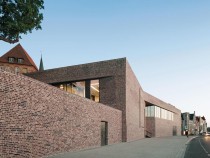
© Werner Huthmacher
Lübeck’s history is inseparably linked with that of the Hanse, the powerful historical guild of merchants and municipalities along the North Sea and Baltic. Numerous listed brick buildings bear witness to this; indeed, the historical city centre of Lübeck belongs to the UNESCO World Cultural Heritage. Not surprisingly, therefore, brickwork in the typical regional reddish colour is a distinguishing feature of the newly founded European Hansemuseum. This is situated on a roughly 7,400 m² site at the northern tip of the historical city island and brings to life for visitors the development of the famous trade association.
In the present case, the construction task included not only the creation of new museum spaces, but the restoration of the neighbouring Burgkloster – or castle monastery – which dates from the 13th century. The elongated two-storey museum is located on the banks of the lower River Trave and extends into the castle hill of Lübeck.
The entrance is situated at the top of a central public staircase that divides the building in the middle and links the historical harbour with the monastery complex at a higher level as well as with the museum grounds. The roof is accessible to pedestrian traffic, and here, surprisingly, a large urban terrace opens up, revealing a broad panorama. The exhibition spaces on the ground floor, laid out in the form of a circuit, are complemented on the upper level by a hall for various events and a restaurant.
In the present case, the construction task included not only the creation of new museum spaces, but the restoration of the neighbouring Burgkloster – or castle monastery – which dates from the 13th century. The elongated two-storey museum is located on the banks of the lower River Trave and extends into the castle hill of Lübeck.
The entrance is situated at the top of a central public staircase that divides the building in the middle and links the historical harbour with the monastery complex at a higher level as well as with the museum grounds. The roof is accessible to pedestrian traffic, and here, surprisingly, a large urban terrace opens up, revealing a broad panorama. The exhibition spaces on the ground floor, laid out in the form of a circuit, are complemented on the upper level by a hall for various events and a restaurant.







